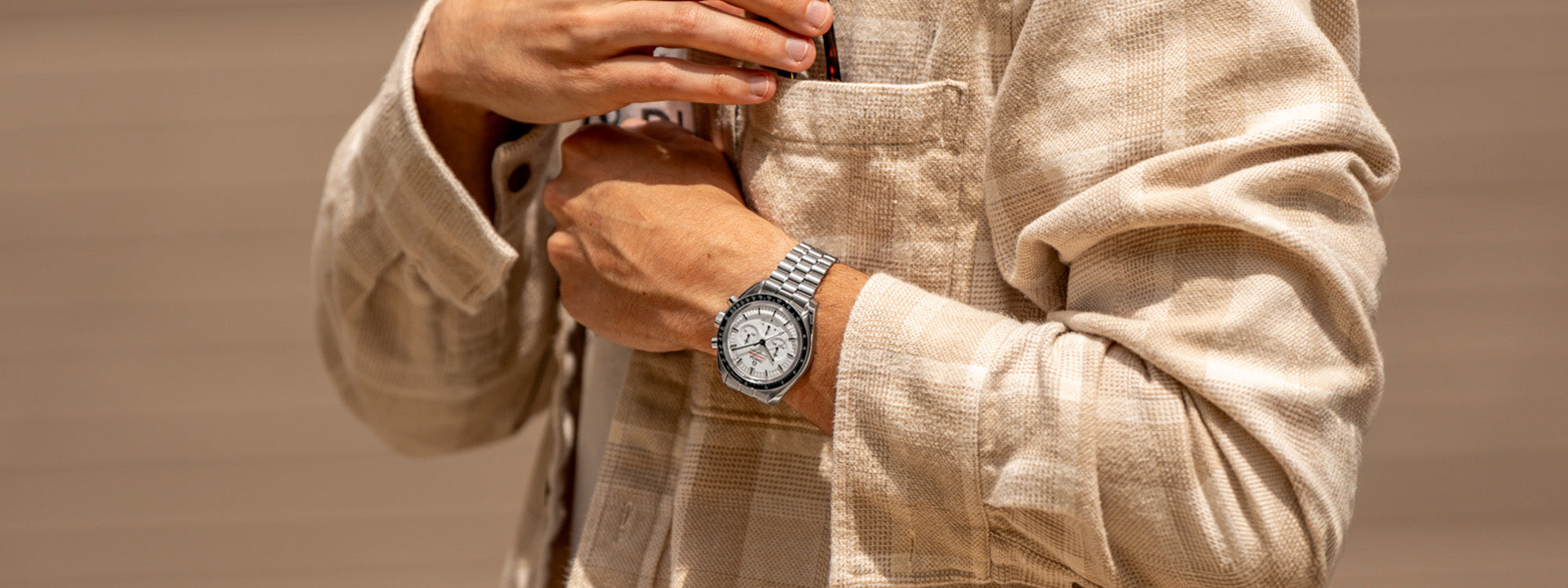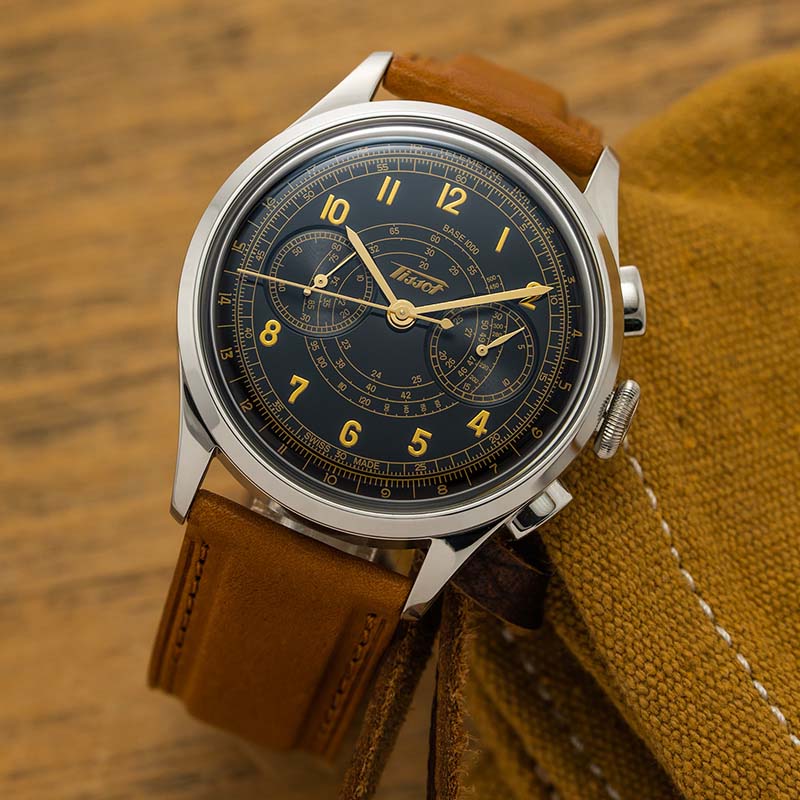Knowing how to wear a watch — to really wear a watch — is like knowing how to wear a suit, or how to choose the right necktie or cuff links, or what to pack for a beach weekend or mountain hiking retreat. It’s a skill set that would seem to be innate but, especially for many newcomers to the appreciation of watches, often comes with a set of questions — questions that many might feel are way too basic to actually ask out loud for fear of looking like a novice. In this article, we compile some of those deceptively simple questions and do our best to answer them.
What wrist should I wear my watch on?

In general, the vast majority of wristwatch wearers wear them on the non-dominant hand — i.e., the hand that you don’t write with, aka the one that is slightly weaker and less dexterous (something we also covered here). For most of the human population — anywhere from 85 to 90 percent, according to studies — this hand is the left hand. Wearing the watch on the non-dominant hand simply makes keeping track of the time while performing the duties of everyday life much easier.
Imagine, for example, trying to write, sketch, or paint with the same hand on which you’re regularly checking the time. Or checking the time on the wrist of the same hand you’re holding a drink in, which could lead to plenty of absent-minded spills. For that matter, try to envision winding or setting your watch with your less dexterous, non-dominant hand. Wearing the watch on the left hand thus makes the most sense for simple reasons of practicality.

However, there are left-hand-dominant folks out there, and they make up a small but substantial 10 percent of the population. For these southpaws, wearing the watch on their right hand is the sensible and practical option. Unfortunately for them, most wristwatches are designed with right-handers in mind — i.e, the crown is on the right side of the case, occasionally along with other features like chronograph pushers — and this makes the options for left-handers relatively few. A handful of watch manufacturers have noticed, and have released timepieces that cater to the needs of this minority; among them are Rolex (with its GMT-Master II), Tudor (with the Pelagos LHD) and IWC, with its Big Pilot's Watch "Right Hander" (pictured above).
Why do some people wear watches with the dial facing inward?

Wearing a watch on the outside of the wrist (i.e., the dial on the same side of the arm as the knuckles) is the traditionally accepted way to do it, and watch cases, bracelets and dials are designed with this configuration in mind. But some wearers choose to flip this around and attach the watch to the wrist in a way that the dial is facing inward (below the palm of the hand).
It’s a quirky way to wear a modern timepiece, but adherents do cite some practical reasons: it’s easier to protect the watch’s crystal from unexpected impacts and the case from scratches and dings; it tucks the watch safely away from light sources that could cause glare, a boon for military and law enforcement officers hoping to avoid detection; it’s more comfortable on the skin; for doctors and nurses, it enables easier time checks while using the wrists for tasks like checking blood pressure; for office workers in tedious meetings, it makes checking the time less conspicuous. If this look appeals to you, you’re in prestigious company: Marlon Brando wore his Rolex GMT-Master this way on the set of Apocalypse Now.
Is it still okay to wear a pocket watch?

Before the invention of wristwatches in the early 20th Century, pocket watches were the go-to option for gentlemen who wanted to carry the time with them in stylish fashion. And while they have long been eclipsed in the market, and in the hearts of many collectors, by their wrist-worn descendants, pocket watches never went away entirely. To be sure, wearing a timepiece in a vest or trouser pocket, rather than on a wrist, in the 21st century is anything but conventional or subtle. For some watch aficionados, it can be a proudly retrograde style statement to complement a boldly chosen ensemble. As a remnant of the Victorian era, the pocket watch has also been adopted by adherents of Steampunk subculture, based around a retro-futuristic style of sci-fi that embraces elements of that 19th-century Industrial Age.
Today, new pocket watches from established wristwatch brands are few and far between — when they are released, it’s usually in limited numbers to celebrate a historical milestone of some kind, or to showcase some crazy new complication that simply won’t fit in a wristwatch case — so they’re rarely spotted in the wild. If you think you can rock one, keep in mind that you will, figuratively, be wearing your quirky historical fetish on your sleeve, even though you will of course have nothing under your actual sleeve.
How large (or small) should my watch be?

This is one of the first questions that newcomers to watch culture tend to pose, to themselves and like-minded friends, and it has no cut-and-dried, one-size-fits-all answer. While there are obviously some practical calculations that you can make, it all comes down to comfort and personal style. Some people with very slender wrists like to rock a big, attention-grabbing timepiece, and occasionally a linebacker type with thicker forearms might prefer to keep it more subtle, with a smaller watch that hides under a sleeve.
Acknowledging that these tend to be the outliers, however, most watch wearers will want some aesthetic harmony between their watch size and wrist size, which means that you’ll want to get an accurate idea of both actual measurements. This is particularly important if you’re buying a watch online without actually physically trying it on.

You can measure your wrist size easily by wrapping a tape measure around its circumference. Measuring the watch case’s diameter (providing you don’t already know it from the manufacturer or the retailer) requires a device called a caliper, preferably one with metric system measurements; watch sizes tend to be measured in millimeters. Simply loosen the caliper’s “jaws” and then screw them tightly around the sides of the case at about 8 and 2 o’clock (avoid the crown) to get your base measurement.
From these two results, you can begin to start matching up watch options with your wrist size. Here are some suggested guidelines based on our own experiences: a six-inch wrist is generally considered “smaller,” so a case size in the range of 34mm to 38mm would be appropriate; an “average”-sized wrist, generally around 7 to 7 ½ inches, can accommodate a larger watch, from around 39mm to about 42mm or even 43mm. On wrists measuring 8 inches or larger, you might opt for what are often termed “oversized” case diameters of 44mm, 46mm, or even larger.
What are some watch styles I should consider?

Trends come and go, but the most popular watch styles all have some elements that have remained mostly consistent. Among these elements are technical and visual facets that tend to determine a watch’s sizing. A chronograph or dive watch that is too small won’t be able to fulfill its primary function of legibility, while a classically elegant dress watch loses much of its understated charm if it’s too dominant on the wrist.
Dress watches, i.e., watches that are generally worn in formal situations and are not overly complicated in their design and functionality, tend to fall in the range of 36mm to 41mm in diameter, with 39mm as a good sweet spot for an average wrist. Many higher-end dress watches (like the Cartier Tank Louis, above) have cases made of precious metals like gold, which is not only heavy but also somewhat ostentatious at larger sizes, making smaller and thinner case dimensions desirable.

Dive watches, as their name implies, are built to be worn underwater, often at great depths, and thus need to be exceptionally water resistant as well as readable deep under water where light doesn’t penetrate. Sizes on some of the most popular dive watches range from 39mm to 42mm (the Rolex Submariner is 40.5mm and the Omega Seamaster 300 Diver, above, is 42mm), but many are even larger. Depending on the level of water resistance, dive watch cases are also substantially thicker than those of non-dive watches. Of course, many dive watches these days are on the smaller end of this range, as they’re built to be more stylish than actually functional for diving (i.e., “desk divers”).

Field watches, first worn by soldiers in the early 20th Century, are generally characterized by toughness in construction, simplicity in dial design, and modesty in case dimensions: the smaller and lighter the watch, the less burden it put on a soldier who was already carrying a load of gear. Nowadays, field watches are mostly larger than their wartime predecessors but still understated compared to dive watches or pilots’ watches: 37mm to 40mm, with a few going larger and a handful of retro models sticking to the classical smaller dimensions, i.e., the 36mm of the classic Rolex Explorer. Both the Bulova Hack Watch and Hamilton Khaki Field Mechanical (above) are 38mm, so that might be considered the sweet spot.

Pilots’ watches, like dive watches, tend to be on the larger side for reasons that are similar yet slightly different: the genre is all about legibility (in a dark cockpit rather than deep underwater), and cases may need to be thicker than usual to accommodate a soft iron inner case to protect the movement from magnetic fields. Pilot’s watches, which are more diverse in their functionalities and aesthetics than dive watches, offer a wide range of sizes, from around 38mm all the way up to the stately 46mm of icons like the IWC Big Pilot’s Watch and Breitling Navitimer (above) — though both models also offer smaller options these days as well.
Bracelet or Strap?

Like just about everything else in the world of watches, and fashion in general, there are few hard-and-fast rules anymore separating Casual from Dressy or Sporty from Luxurious. That said, one of the big decisions facing any prospective watch purchase is choosing which type of strap or bracelet it should have. Watch straps are more versatile than bracelets, varying widely in their materials, construction, finishing, and even in their original intended usage.
Some straps project a sense of genteel refinement while others exude military ruggedness or everyday sportiness. An alligator or crocodile leather strap is generally associated with luxury, while a calfskin strap is a bit more casual; a very rugged calfskin with prominent stitching is particularly reminiscent of vintage pilot’s watches and adorns many aviation-inspired timepieces today.

Rubber, also a popular material for watch straps today, has several practical advantages over leather, being stronger, more resilient, more pliable (i.e., it returns to its original shape after bending), and more resistant to water and higher temperatures. Rubber straps for watches became more mainstream in the 1960s with the rising popularity of recreational diving and the demand for water-resistant divers’ watches that came with it. Rubber straps — despite the fact that they’ve now been used on some decidedly luxurious timepieces ever since Hublot pioneered that pairing back in the ‘80s — are a visual cue that the watch you’re wearing is suitable for sport as well as seriousness.

Bracelets, as a category, tend to project a sportier look, though many watches with bracelets have been overwhelmingly accepted into the “luxury” category, notably including integrated-bracelet classics like the Audemars Piguet Royal Oak (above), Patek Philippe Nautilus, and Vacheron Constantin Overseas. The range of styles offered by watch bracelets these days is also wide, from the more tool-oriented three-link Oyster style pioneered by Rolex, to elegant options like the supple “beads of rice” style and the flexible mesh “Milanese.” Also, keep in mind that any bracelet, like any case, can be dressed up by adopting a “two-tone” look, such as by adding a row of gold inner links to a set of steel outer links.
How do I coordinate my watch with my outfit?

As with any other accessory, choosing what watch to wear with any given ensemble should be approached with some level of thoughtfulness and an eye toward complementary styles and colors. A formal suit might call out for a minimalist dress watch, for example, while colorful beachwear would look best with a dive watch on a bright rubber strap.
Consider matching your watch’s strap color to the color of your belt and/or shoes, its dial color to a prominent color in your shirt, suit jacket, or tie, and even be cognizant of details like coordinating the metal of your case with the metal of your belt buckle, cuff links, or jacket buttons. A watch can certainly be a bold statement, if you so choose — just ask the modern generation of attention-seeking “double wristers,” who love to wear two or more watches at once — but most often it works best as part of a well-coordinated, “put-together” look.
Are there any occasions when I shouldn’t wear a watch?

The venues, and circumstances, that traditionally call for watch enthusiasts to leave their timepieces at home have drastically diminished in number as social conventions loosen and watches themselves adapt. At one point, it was common practice at very formal “black tie” events to not wear a watch at all, but now there are many elegant, understated dress watches that many consider appropriate. Wearing a watch while swimming or showering was once a no-no, but improvements in water resistance, for both cases and straps, have made it much safer to leave your watch on in the pool.
There are still some high-contact sports that are much wiser to play with your watch off — football, basketball, hockey, et cetera — but more and more golfers and tennis players are wearing watches during play, thanks to improvements in shock resistance and general robustness. (Rafael Nadal, above, even had special match-ready watches made for him by Richard Mille) Watches have truly become ubiquitous almost everywhere, but there is still some etiquette involved. For example, if you happen to be elected to a high political office, by all means, don’t be caught on camera checking your watch during a debate or while attending a military funeral. There is a time and place for everything.






















































0 Comments